#original painter: Sir Lawrence Alma-Tadema
Text
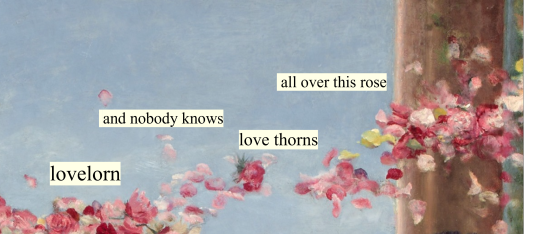
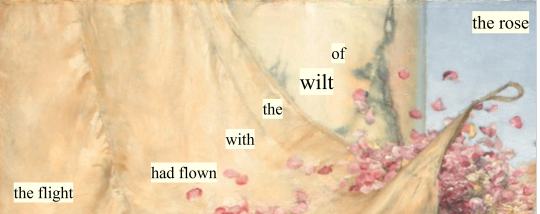
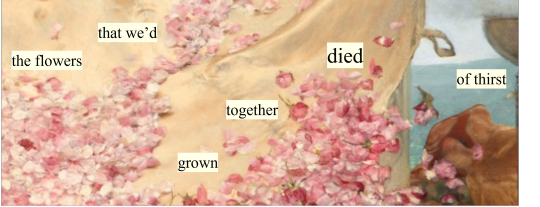
slut! // is it over now? // clean
#my edit#taylor swift#1989#1989 taylor's version#1989 tv#is it over now?#original painter: Sir Lawrence Alma-Tadema#clean#haylor#tswiftlyrics#lyric edit#taylor swift lyrics#tswiftedit#harry styles#typography#lyric parallels#taylor swift lyric parallels#1989 lyric parallels#The Roses of Heliogabalus#1888 - oil on canvas. — Sir Lawrence Alma-Tadema#Sir Lawrence Alma-Tadema#lawrence alma-tadema#art#paintings#sir lawrence alma-tadema#art details#classical art#oil painting#classic art#oil on canvas
580 notes
·
View notes
Text
Explaining One of VTMB Paintings (part 15)
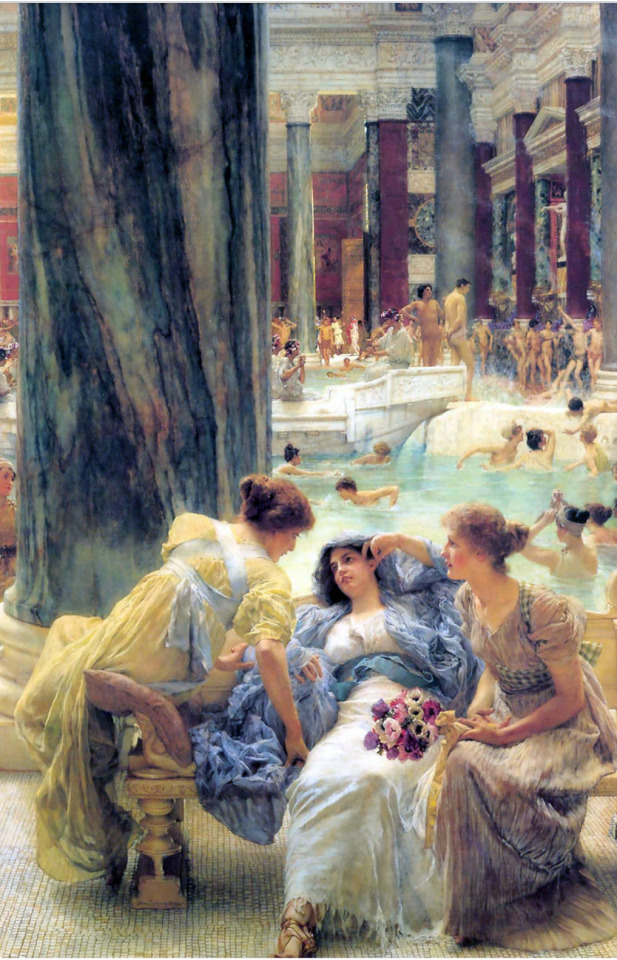
The Baths of Caracalla, oil on canvas (1899) by Sir Lawrence Alma-Tadema
Sir Lawrence Alma-Tadema(Jan 8 1836- Jun 25 1912) was a Dutch painter born in Dronryp , Netherlands and later became a UK denizen(an old legal status were you were able to own land and like in the UK without being a Citizen but still enjoying most of the rights). His art styles include both Romanticism (which this painting is) and Neoclassical.Before 1860s many of his works were of Merovingian subjects(Merovingian Dynasty was a Frankish(Germanic people who lived in what’s now part of Modern day France) ruling family in power from the mid 5th century to 751). His painting The Clotilde and the Tomb of her Grandchildren [1859 ](see below) is an example of Merovingian subject matter in a NeoClassical style. Despite his foundness Merovingian subject was not very popular on the international art market so he switched to painting focused on more popular subjects to depict in his artwork mostly focused on as historic/ ancient Egyptian, Roman and Greek subjects and events.

The Clotilde and the Tomb of her Grandchildren, oil on canvas (1858) by Sir Lawrence Alma-Tadema
Romantic art focused on emotions, feelings, and moods of all kinds including spirituality, imagination, mystery, and fervor. The subject matter varied widely including landscapes, religion, revolution, and peaceful beauty. The brushwork for romantic art became looser and less precise. The great Romantic artist Caspar David Friedrich summed up Romanticism saying "the artist's feeling is his law".
The Baths of Caracalla is a real Roman public bath built in Rome, Italy (the second largest in the city) sometime between 212 AD and 217 AD and was in operation until around 537 AD when it fell into disuse. The paining shows the historical imagination of what the baths would have looked like during the height of its popularity as it would be a major social space public space.
Historically Roman public baths acted as community centers where free and included access to a wide verity of atonal features such as gymnasiums for men to exercise; statues, murals and other public works of art; restaurants to buy multiple types of food and even a library that allowed everyday Roman citizens access to literature works they wouldn’t be able to offers to buy. Roman Public baths acted as not only bath houses but as a Library, gym, spa, restaurant and public art gallery. The waters of the baths were heated by a hypocaust, a heating system where coal and wood is burned under the ground.

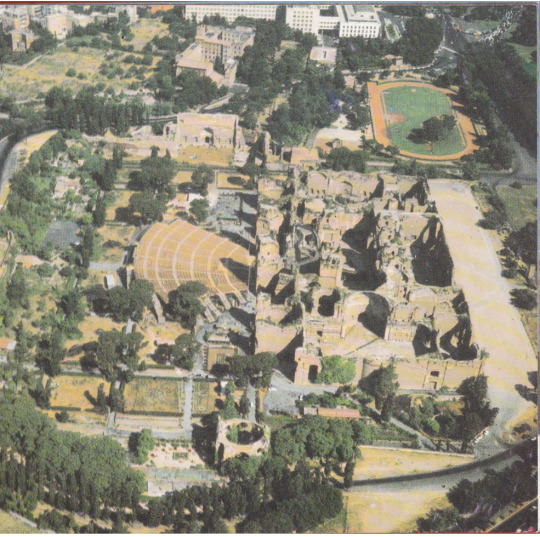
The baths were most likely built by emperor Septimius Severus (part of the Severan Family) as they are located in the southern part of Rome where during that time members of Severan family were known to commission a number of public works in that specific area of the city for political favor. The site the baths were built on where originally part of a Garden estate known as horti Asiniani by Gaius Asiniani Pollio during the reign of Augustus( first emperor of Rome 63 BC to 14 AD, so about 200 to 260 years before the construction of the baths). The Garden was home to a number of sculptures such as the Farnese Bull which were kept as part of the public art displays of the baths when they were in use. During the height of its popularity the baths are estimated to have a daily capacity of 6,000 to 8,000 visitors a day.

Farnese Bull, marble sculpture (2nd century BC) by Apollonius of Tralles
Even after falling into ruin the Caracalla baths still found use as in the 14th century a Christian pilgrim site was set up near by due to the proximity to the Church of Saint Nereo e Achilleo( built facing the baths in the 4th century) and was used by the pilgrims as their main water source. But in 537 AD during the war of the Gothic war the city’s water supply was cut by Vitiges of the Ostrogoths and the baths were once again abandoned.

During the 6th and 7th century the baths were still in the very sparely populated area of Rome and were used to burry pilgrims who died in the xenodochium ( hospital specifically for treatment of foreign pilgrims) of the Church of Saint Nereo e Achilleo. Then starting in the 12 century the baths were used as a quarry for stone and decorative masonry that were often used in the construction of churches. In the 15th century Pope Pius II used stone from the baths in the construction of the Loggia of the Benediction (fancy decorative balcony used by the Pope) at St Peters Basilica, Vatican City. (See photo below)
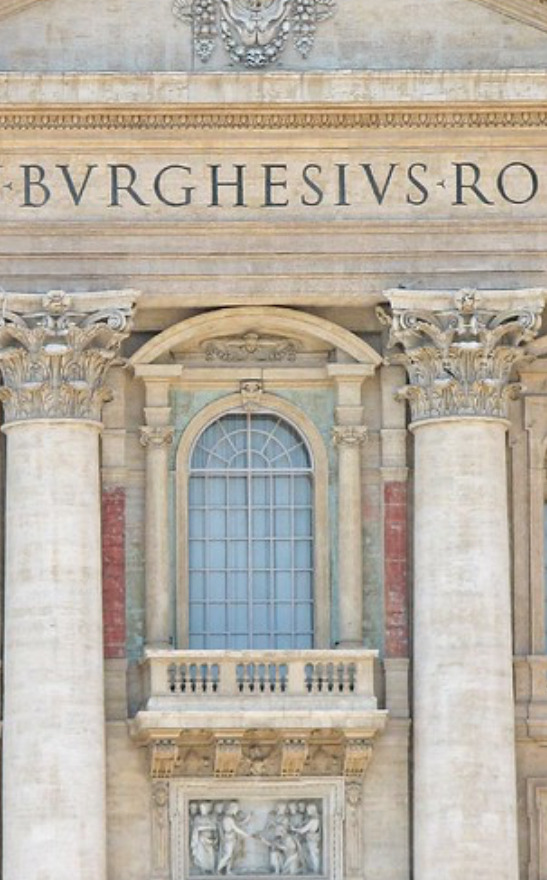
it wasn’t until the 16th and 18th century when interest in restoring the Baths as a historic site began. With the excavation of the baths beginning in 1824 by Count Egidio di Velo.
The Baths of Caracalla have been a popular subject of a number of different art works over the years by a wide number of artist who ether are depicting historical scenes of artist imaginations of the baths in its prime or capturing architectural beauty that remained even after it fell into ruin. (see examples below)

Baths of Caracalla Rome: interior of the Tepidarium, watercolor (1845) C.R. Cockerell and assistant Jackson used in lecture of architecture. Image based on illustration based of detailed restoration done on the baths found in a book published by French architect G.A Blouet in 1828.

Interior of the Baths of Caracalla, print if etching with watercolor and gouache(circa 1780) by Swis painter and engraver Abraham-Louis-Rodolphe Ducros.
#vampire the masquerade bloodlines#VTMB#explaining one of vtmb paintings#art history#romanticism#The baths of Caracalla#Ancient Roman#Sir Lawrence Alma-Tadema
1 note
·
View note
Note
Might we get some Sebastian Zollner soft smut 👀 maybe even like young him when he was still trying to do his own painting and you were his nude model

The Artist and his Muse [Sebastian Zöllner x his Muse]
Word count: 3k
Warnings: Smut, bit pf fem!dom and a mess of a man
A/N: As usual Sebastian is my weakest spot. The painting here is "In the Tepidarium" by Sir Lawrence Alma-Tadema.
You stood there quietly, a sense of expectation taking over you when he opened the door at you. You noticed him from day one and now you had to wrap the situation between the two of you.
"There you are"
He only said letting you inside, a second voice greeting you.
"Hey! Seb is that your girlfriend?"
He waved at his flatmate to shut up as he put an hand on your lower back pushing you to get out of that situation fast.
As you got into his tiny room it was a mess.
The space was small, scattered art books and biographies of great artists everywhere on the floor, on the big inclined drawing desk, one of those like architects had. Then drawings, drawings everywhere from the floor to the walls, from over the bed to every visible corner of the room.
Also mugs, ashtrays filled up everywhere, more mugs used as ashtrays and some leftover food also used as ashtray.
The place would have been grey and dull if it wasn't so chaotic and full of colours.
You also noticed from the big amount of duvets over the bed that the place was cold.
"Get your stuff here"
He said moving his, hopefully clean, clothes off a chair so you could lean your stuff there.
"Thank you for coming" he added briefly and you smiled.
"Thank you for inviting me"
It wasn't like you had much choice, you posed for the art academy, but some extra money was always nice and he daunted you for weeks by now, so in the end you said yes.
"So, let's begin or do you need anything?"
"Some water would be nice" you said as he nodded taking a glass full of dirty water, probably used to get wet the brushes, and going away. You heard him throw it away and briefly wash it before coming back to you with the glass full of water and still half dirty.
You smiled as you took it taking a sip only to be polite putting it back on side.
"Now please" he gestured something, he did a lot of hand gestures and a lot of waving like he was constantly trying to get rid of some smoke surrounding him.
"Get naked" he concluded and you nodded quietly undoing your dress as he looked away to look trough some of all those sketches he had around the room finally showing you a sketch of a standing naked figure, he clearly had some ideas for the background and it was quite classic as structure.
"You can hold this" he said handing you a ball "hold it low, around here" he said pressing the ball over your lower stomach.
"You know ,like a fortune teller" he said before giving you his back to prepare the easel and put on the canvas. You notice he sketched the back of it, so he probably didn't have all of that money. The chances to be paid becoming small by minute, but you were here and he was awkward enough to intimidate you a bit.
You put the ball down and proceeded to undress, you folded your clothing over the chair he freed for you and piled them neatly before picking the ball again.
"ruffle your hair, I need a kind of unkept vibe"
you nodded as you held the ball under your arm and with one hand you ruffled your hair standing nicely in place as you put the ball back to its position.
He stared at you as he leaned on side, he jerked his hand blindly on side to turn on the small radio to some low indie pop channel.
You took your time to observe him as you stared in front of you.
He had longish hair and he tied them up into an half bun, a soft beard. He wore a used t-shirt from the band The Smiths already stained with colour and some blue pants that must be his kind of working from home uniform.
He was barefoot and you noticed he bowed his feet inward as he got pensive, like a way to get extra relaxed.
He was cute, you had to admit it. He was also the first in line most of the time during real life drawing lessons, you could tell he was striving for it but he didn't take well criticism. He would glare and frown at every critic, nag at his bottom lip as he resumed his sketching every time with more passion.
It was always weird to go and see a student on your own. When you were working at the academy it was easy because you had a clear shift and pauses, while when working with artists alone you always had to give in some time.
"Relax your shoulders"
You blinked like his words woke you up and you took a deep breath resuming your position.
"It is a study for a classical image, you know something like Alma Tadema works, only modern" you smiled as you liked that painter and you nodded.
Silence took over as he observed you and disappeared behind the canvas. He was nervous from the moment you agreed to meet him alone. he felt like a creep because he always had a bit of a crush on you and he was upset when for a reason or another you were not the model on certain days. You were everything he liked, every proportion of your body was the ideal he had as an artist.
He sketched your shape as for once he had all the time, no change of position, nobody calling it too difficult or interrupting the moment.
He huffed softly as he got too excited awaiting for this moment he couldn't sleep at night and he even cleaned up his room. Well, you could tell he tried.
He observed every detail of you: from the way you had little moles scattered on your body that he never noticed before to the way your collarbone met deliciously under your neck, how your shoulders drifted up every now and then to unease the tension from the lack of movement. He bit on the inside of your cheek as he sketched the navel of your hips, the delicious curve where so many times he imagined to bury his head into, to be kept safe from the welcoming world of your female form, the origin of the world of erotica.
He frowned as you moved to take a sip of water, he looked at the time, 30 minutes already gone?
He stared down to the canvas as he had to focus, focus focus.
"Seb?? Do you have my lighter??"
A male voice that you guessed belonged to his flatmate shouted and he picked a cigarette
"NO" he shouted louder as the other guy groaned from behind the door, you smirked as you watched him light up his cigarette with a metal lighter and blow some smoke.
He resumed his sketching and you relaxed after some time, your eyes darting away as you barely saw him beside the smoke raising from behind the canvas.
"SEB"
Another shout interrupting but this time it was another flatmate that just bounced the door open. You gulped in surprise as you didn't have anything at hand to cover yourself
"What shit is this? What kind of pervert are you?"
The guy asked as Sebastian thew the pencil at him.
"Fuck you" he shouted "get the fuck out, out!" he jumped off his seat throwing the lit cigarette at him. And that’s why you hated to go to people's houses. Other that don't study art looked at you like that, like something dirt ,like a naked woman.
You sighed as you moved toward the bed covering yourself with one of the countless duvets scattered in the room, it was warm and soft at least. You looked away trying to zone out from the little fight going on between Sebastian and his the other guy.
"Sorry"
He said as he locked the door and pushed the drawer in front of it huffing and panting as he came to you showing with a gesture of his hand your way back to that position.
"No, look it is better if I leave, if you want to do it a private session let's do it at the school" you said as you got enough of that place and his flatmates and you also realised that if he lived in that chaos he probably didn't have the money to book the room and also pay you.
"no, no, no, no" he repeated as he moved after you as you marched to collect your belonging.
"please, they are just idiots" he said as he looked like he was ready to have a panic attack.
"I can see that myself, so that's better to end it now"
"no, no you don't understand"
You chuckled as you looked at him "don't understand what? the power of art?" you inquired as you had heard all sorts of excuses about it.
"I need you"
He said helplessly as your frowned and looked away as he gabbed you by your duvet yanking you back a little.
“I don’t work with other models, I can’t process it, when you’re there I am productive, I work and overwork, and my head is full of ideas, of hopes and more and more ideas, I can see things in perspective, I can feel it, it is like a raging fire and I need you t make it start, just please, just listen to me”
You tried to focus onto what was around you and there's when you noticed that from this new perspective you saw the sketch.
You moved closer to it as you admired how delicate was Sebastian's hand, he made little traits, quick slashes that made your figure look like you had never seen yourself before and you had actually seen a lot of sketches of yourself, so many pointing out unflattering things about your body that you tried to avoid having a look at those sketches.
"it is rough, don't" he said as he still held you by the duvet but he noticed you look up at the canvas.
He had never been this close to you. You smelled like fresh flowers and soft creamy after bath lotion, one of those that say your skin will be like honey and milk. He was sure you tasted like it.
He gulped down nervously as now this was widely unprofessional and he would have given all he had to avoid this moment and yet he daydreamed of it for so long while watching you getting dressed after the lesson.
"I apologise, I swear, I never.. I mean I know this is not the best place but I never felt like I do with you before and I didn’t want to screw it up on the first time”
You didn't really had the time to answer as he clashed his lips over yours grabbing the sides of your face with his hands and it was so desperate like he was about to break down.
You pushed him off as he frowned visibly. He looked so taken aback and saddened now.
You almost chuckled to his face as he looked like a pup that got smacked in the muzzle for biting onto something pricy.
You tugged him by his shirt still wrapped up in that duvet pushing him to sit down.
He opened his mouth but nothing came out of it when you moved to straddle him.
"Stay still"
You said as you moved your hand to his jaw making him close his mouth, he stared at you as you brushed you lips against his, he looked at you intensely before closing his eyes and letting you guide him into that kiss. He let out a soft sound as you showed him what kisses are made for, not that fearful rushed slamming from his mouth to yours.
"You're a goddess" he whispered softly as he leaned for another kiss. He pulled onto that duvet now hungry for more.
"Calm down, don't rush so much" you whispered as he almost didn't know what to do with himself. He was hard already, he was desperate for you that colonised his dreams for so long.
"Damn" he groaned as you lowered your hips against his. He stared at you panting softly as you started grinding against him, the fabric of his joggers was soft but you would have endured some itchy feeling just for the way he trembled and groaned from the friction you gifted. You were sure his boxers must be filled with precum already.
"Can I touch you?"
"Not yet" you whispered. You loved the way he draw you, you saw all the desire behind it and he deserved to enjoy it and not to rush through it.
"Fuck please, i have never" he stopped himself as you looked at you curiously.
"I did everything but that" he said as he tried to avoid to mention how usually girls got so annoyed with his that after a very good cunnilingus they would ask him to leave.
"even better then" you said as he looked so nervous it was adorable. you leaned in and kissed him again as he let you take off his shirt as he stared at you adoringly, the duvet falling off your torso as his eyes fluttered closed letting you guide him in the kiss, he had a lot to learn but he was eager to.
You swiped your tongue over his lips as he parted them and groaned as you joined your lips in a more eager kiss, your tongue trying his as his hips jerked aimlessly against you trying to get some relief, but you moved your hips away not willing to satisfy him too fast. He was used to stare at you, to long for you with his eyes and now he had to persevere in that.
You pulled back from him moving to stand up between his legs letting the duvet fall off your body, now the act taking a whole new meaning for him as you kneeled down taking off his clothing.
You pushed his cock out slowly stroking it, your cold fingers making him hiss as you pumped him slowly, your lips moved across his cock slowly sucking on it and tracing its length with your tongue.
“If you cum I will leave”
The threatening enough to make him groan, he couldn’t take his eyes off from you even if that made him only more horny.
“Fuck” he hissed as you sucked on his needy tip already spread with premium, your tongue twirling over it before taking it whole in your mouth.
Oh the strangled moan he let out.
He held over the edge of the bed like a dear of life, your bobbing head making him lose his mind, you let out soft moans and humming sound that echoed through his whole body.
“Fuck”
He repeated, more helplessly than before if possible, as he closed his eyes, he squeezed them as his thighs trembled eagerly fighting against his natural eager nature.
You pulled back as you stood up and he let out a loud groan.
“Look at you, already a mess”
You smirked as you moved to straddle him, your bare slit tracing his cock like your tongue just did before letting the tip of it inside you, then you pulled back making him cry out.
Once again, his hips jerked up helplessly.
“Please” he groaned “I need it, I need it” he begged as you held him by his jaw with your left hand as your right one guided him inside you.
You stared at him as you did, his eyes widened, his pupils blown as your warmth engulfed him and wrapped him in a dense sense of pleasure.
“Move, move”
Your leaned your head on side
“Please”
You still didn’t wince, he parted his lips not knowing what to say.
“You have been staring at me like that all that time, do you think I didn’t notice?” You whispered as he licked his lips nervously
“You used me for your little dreams didn’t you? I bet you wanked like a loser with your sketches, you were getting hard on the first day only”
He whined like a suffering cat his thighs trembling as he was bouncing on his heels lightly
“Am I wrong?”
He shook his head to you and you smirked
“I have been your fantasy, now, you’re going to be mine”
He moaned as you begun to move, your lips meeting his as he sucked onto your finger before you moved your own hand to rub your clit, he was completely out of his zone. He used to be hungry and straightforward and now he was just an idiot who didn’t know where to place his hands.
“My muse” he groaned as your moves were making him go wild, his hips jerking against yours “my muse”
He repeated it as you pushed him to lay onto his bed, your sensual bouncing over his lap making any sane man become a priest for your religion.
“Fill me Sebastian, please me”
You moaned as you rubbed over your own clit as he squeezed your thighs unable to phantom any move, to focus.
His mouth hanged open, he licked his lips and groaned, your permission making him lose control as he released inside you.
He kissed onto your lips rising to sit up, arms around your waist as he nuzzled helplessly against you.
A whole new world open in front of him.
“Do you want to paint me now?”
He nodded looking up at you, hair stuck up to his sweaty forehead as he looked so lost, pupils blown and erratic breath.
You smiled tenderly to him tracing his face with your fingertips guiding him into another kiss that he won’t forget for a lifetime.
Tagged @cazzyimagines @lieutenantn @handmaiden-of-mischief @thesunflowersutra @zemomybeloved @fictionlandslanddreams @charistory @greeneyedblondie44 @apparrio @hb8301 @whatawildone @rhymerhymerhyme @thehuiabird @lilith-blackrose @unbeatablecurlgirl @obsidianlaszlo @alindeluce @zemosimp05 @baronesszemo-blackwood @nocapesdahling
#sebastian zöllner x y/n#sebastian zollner smut#sebastian zollner x y/n#sebastian zöllner x reader#sebastian zöllner x you#sebastian zollner x reader#sebastian zöllner headcanon#sebastian zollner#sebastian zöllner#ich und Kaminski fanfiction
126 notes
·
View notes
Text
Mummy Brown: A Most Tragic Hue That Everyone Used
Millions of people walk the hallowed halls of the Louvre every year to see some of the most important masterpieces of all time with their own eyes. With 35,000 pieces on display there is a lot to take in, and among them is Interior of a Kitchen by Martin Drölling. The scene is tranquil, showing an illuminated country kitchen where a young girl works on her needlework, another woman sits in her chair, and a girl sits on the floor playing with a cat. The detail is exquisite, and although the view from the window is bright the majority of the scene is painted in varying shades of brown, and it is this brown hue that places Interior of a Kitchen in a unique category. Drölling painted the work in 1815, but his paint had origins in ancient times.

Interior of a Kitchen by Martin Drölling. Image via Wikipedia.
In the Medieval age medicine was still in its infancy, but one substance that was highly sought after for its medicinal purposes was bitumen. Referred to as early as the twelfth century, it was a substance believed to cure nearly any ailment. Bitumen was found naturally in the earth in the Middle East region, but rather than extracting it from the ground, it was believed that it could be obtained from another source, the long-dead bodies of ancient Egyptians. The Persian word for bitumen was “mum” or “mumiya” which lent itself to the word “mummy” and the black color of the wrapped corpses led people to (falsely) believe they were soaked in bitumen during the embalming process. It was impossible to extract the alleged bitumen from the mummies, so they ground up the dead ancient bodies and used that instead.
By the fifteenth century it was commonplace for merchants to visit Egypt and send large shipments of mummies back to Europe for an eager consumer looking to grind them up for medicine. At the time there were incalculable numbers of mummies at their disposal and according to Thomas Pettigrew’s History of the Egyptian Mummy the author writes, “No sooner was it credited that mummy constituted an article of value in the practice of medicine than many speculators embarked in the trade; the tombs were sacked, and as many mummies as could be obtained were broken into pieces for the purpose of sale.” After being lowered into the tombs merchants picked their new cargo and paid the inexpensive prices before loading their ships with bodies and parts that were doomed for the grinders of Europe. Once reduced to powder, the dead would be mixed into topical balms or straight into drinks to be immediately ingested. The demand for mummy medicine ran high with little to no consideration if the body was old, young, male, female, or cause of death. It was a trend that continued well into the 18th century.
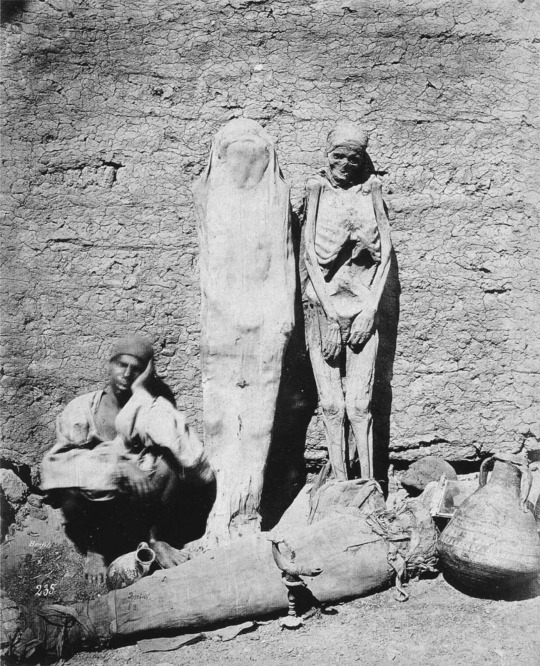
Merchant selling mummies on the street. Image via rarehistoricalphotos.com.
By the 1830s the general public became obsessed with all things ancient Egypt and relics from the time became highly desired collectible pieces with a mummy being at the top of everyone’s wish list. The ferocity in obtaining mummies sent people tearing into sacred sites and haggling with sellers on the streets who claimed the bodies they were selling were genuine. The monk Father Géramb stated in 1833 that “it would be hardly respectable, on one’s return from Egypt, to present oneself without a mummy in one hand and a crocodile in the other.” Once brought into the homes of Europe as unfortunate souvenirs the fascination with Egypt’s ancient dead manifested in mummy “unwrappings” or “unrollings” that began as scientific undertakings but evolved into public events that would often sell out. As the wrappings were unfurled those gathered would delight in the trinkets that would fall from them, the pieces of paper tucked inside, and the sight of the blackened body before them.
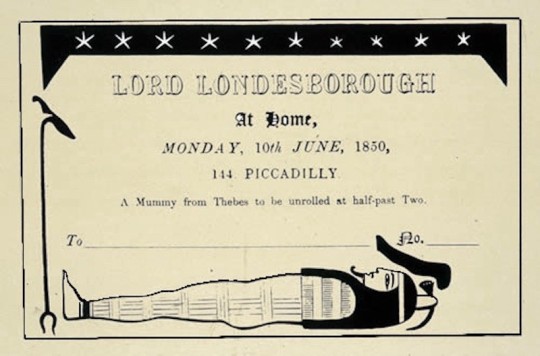
Flyer for a mummy unwrapping circa 1850. Image via medium.com.
Considering how Europeans strived to incorporate ancient Egyptians into their daily lives it is not surprising that they also made them a part of their art. With a shade resembling burnt umber, Mummy Brown was made by mixing white pitch, myrrh, and the ground-up remains of ancient Egyptian mummies. Beginning in the 16th century the paint became extremely popular with artists because of the unique pigment that could only be obtained from the mummies because of the specific substances used in the mummification process.
The use of Mummy Brown reached its height in the mid-eighteenth to nineteenth centuries when it was used by such famous artists as Sir William Beechey, Edward Burne-Jones, Lawrence Alma-Tadema, Eugene Delacroix, and Martin Drölling who used the paint extensively in Interior of a Kitchen. What is unclear though, is if artists knew exactly what they were painting with.
One artist who was unaware of his paint’s dark origins was pre-Raphaelite painter Edward Burne-Jones. As recalled by his nephew, author Ruyard Kipling, his uncle was spending a day with fellow artist Alma Tadema in the 1860s when he learned that the pigment’s name was not a metaphor, that the paint he had been using was in fact made from ground up mummies. Deeply disturbed by this, Burne-Jones went into his studio and came back downstairs stating that if it was made from dead Pharaohs then the tube in his hand needed to be buried immediately and with proper honor. According to Kipling’s later account of the day, “So we all went out and helped – according to the rites of Mizraim and Memphis, I hope – and to this day I could drive a spade within a foot of where that tube lies.”

Edward Burne-Jones. Image via Wikipedia.
The origins of Mummy Brown were never kept secret, but over the centuries people seemed to forget that the color’s name was literal. As the facts of the paint’s origin came back into collective knowledge people grew increasingly uncomfortable with the idea of painting with ancient human remains. C. Roberson and Co., one of the leading colorists of the 19th and 20th centuries, included Mummy Brown in their catalog until 1933. It took just over three more decades for the production of Mummy Brown to be officially declared over. The reason was as simple as it was tragic, there were no more mummies to use for paint. As stated by the managing director of C. Roberson and Co., “We might have a few odd limbs lying around somewhere, but not enough to make any more paint. We sold our last complete mummy some years ago for, I think, £3. Perhaps we shouldn't have. We certainly can't get any more”

Tube of Mummy Brown paint. Image via artinsociety.com.
Today the color Mummy Brown is made from materials completely unrelated to human remains. While it is known when the production of the color was finally stopped, it is difficult to estimate just how many works of art were created using the paint. In an unfortunate twist, many of the artists active at the height of Mummy Brown’s usage painted scenes of ancient Egypt making it entirely possible that the sacred deceased of Egypt were taken from their tombs only to be ground up and used to paint them.
Sources:
Ground Up Mummies Were Once an Ingredient in Paint by Rose Eveleth. https://www.smithsonianmag.com/smart-news/ground-mummies-were-once-ingredient-paint-180950350/
The Life and Death of Mummy Brown by Philip McCouat.
http://www.artinsociety.com/the-life-and-death-of-mummy-brown.html
Was This Masterpiece Painted With Ground Mummy? by Kristen Romey.
https://www.nationalgeographic.com/news/2016/09/mummy-art-painting-delacroix-pigment-ancient-Egypt/
#Husheduphistory#featuredarticles#history#AncientEgypt#AncientEgyptianHistory#Mummy#Mummies#arthistory#colorhistory#pigmenthistory#painting#paintinghistory#tragichistory#forgottenhistory#regrettablehistory#weirdhistory#strangehistory#creepyhistory#whatsinaname#historyiswild#historyisnotborning#historyclass#artclass#disrespect#shockinghistory#sadhistory#ingredients#paint#burntumber#pharoah
10 notes
·
View notes
Text
Alighieri Dante (c. 1265–1321) La Divina Commedia Inferno Canto V. I. 1-15 Minos who judges the second circumference, 13-15., 15. Dicono e odono e poi son giù volte. (Says and hears and then below times.), Workshop of Robert Campin (Netherlandish, ca. 1375–1444), Mérode Altarpiece, ca. 1427–32, The Metropolitan Museum of Art., Hugo van der Goes (Flemish, c. 1430/1440–1482), The Monforte Altarpiece, c.1470, Gemäldegalerie, Berlin. Hugo van der Goes 31.03.2023 bis 16.07.2023 Gemäldegalerie, The Portinari Altarpiece, 1475-76, Uffizi Gallery., Jean-Antoine Watteau (French, baptised 1684-1721), Pèlerinage à l'île de Cythère, 1717, Louvre., Pilgrimage to Cythera, c. 1718–1719, L'Enseigne de Gersaint, c. 1720–1721, Charlottenburg Palace, Berlin., Sir Lawrence Alma-Tadema, OM, RA (Dutch, 1836–1912), The Roses of Heliogabalus, 1888
Alighieri Dante (c. 1265–1321) La Divina Commedia Inferno Canto V. I. 1-15 Minos who judges the second circumference, 13-15., 15. Dicono e odono e poi son giù volte. (Says and hears and then below times.), Workshop of Robert Campin (Netherlandish, ca. 1375–1444), Mérode Altarpiece, ca. 1427–32, The Metropolitan Museum of Art., Hugo van der Goes (Flemish, c. 1430/1440–1482), The Monforte Altarpiece, c.1470, Gemäldegalerie, Berlin. Hugo van der Goes 31.03.2023 bis 16.07.2023 Gemäldegalerie, The Portinari Altarpiece, 1475-76, Uffizi Gallery., Jean-Antoine Watteau (French, baptised 1684-1721), Pèlerinage à l'île de Cythère, 1717, Louvre., Pilgrimage to Cythera, c. 1718–1719, L'Enseigne de Gersaint, c. 1720–1721, Charlottenburg Palace, Berlin., Sir Lawrence Alma-Tadema, OM, RA (Dutch, 1836–1912), The Roses of Heliogabalus, 1888
https://blog.naver.com/artnouveau19/222653597869
Alighieri Dante (c. 1265–1321)
La Divina Commedia
Inferno
Canto V.
I. 1-15
Minos who judges the second circumference
Sempre dinanzi a lui ne stanno molte: (Always in front of him from there they are a lot.)
Vanno a vicenda ciascuna al giudizio, (Goes in turn everybody to the judgement.)
Dicono e odono e poi son giù volte. (Says and hears and then below times.)
Workshop of Robert Campin (Netherlandish, ca. 1375–1444 Tournai), Mérode Altarpiece (Annunciation Triptych), ca. 1427–32, Oil on oak, Dimensions: overall (when open), 25 3/8 × 46 3/8 in.; central panel, 25 1/4 × 24 7/8 in.; each wing, 25 3/8 × 10 3/4 in., The Metropolitan Museum of Art. On view at The Met Cloisters in Gallery 19
https://en.wikipedia.org/wiki/Mérode_Altarpiece
https://www.metmuseum.org/art/collection/search/470304
Hugo van der Goes (Flemish, c. 1430/1440–1482), The Monforte Altarpiece (Adoration of the Magi), c.1470, Oil on wood, 147×242cm (58×95in), Gemäldegalerie, Berlin.
https://en.wikipedia.org/wiki/Monforte_Altarpiece
Hugo van der Goes
31.03.2023 bis 16.07.2023
Gemäldegalerie
Hugo van der Goes (um 1440-1482) war der wichtigste niederländische Künstler der zweiten Hälfte des 15. Jahrhunderts. Tätig in Gent und Brüssel, gehörte er der zweiten Generation altniederländischer Meister an, die den Pionieren Jan van Eyck und Rogier van der Weyden folgte. Seine Werke wurden von den Zeitgenossen aufs Höchste bewundert und bis ins 17. Jahrhundert hinein vielfach kopiert. Noch Albrecht Dürer nennt ihn 1520, wie nur ganz wenige andere Künstler, einen „großen Meister“. Die Gemäldegalerie präsentiert 2023 die erste ihm gewidmete Sonderausstellung.
https://www.smb.museum/ausstellungen/detail/hugo-van-der-goes/
Hugo van der Goes (c. 1430/1440 – 1482) was one of the most significant and original Flemish painters of the late 15th century. Van der Goes was an important painter of altarpieces as well as portraits. He introduced important innovations in painting through his monumental style, use of a specific colour range and individualistic manner of portraiture. From 1483 onwards, the presence of his masterpiece, the Portinari Triptych, in Florence played a role in the development of realism and the use of colour in Italian Renaissance art.
https://en.wikipedia.org/wiki/Hugo_van_der_Goes
Hugo van der Goes (Flemish, c. 1430/1440–1482), The Portinari Altarpiece, 1475-76, Oil on wood, Uffizi Gallery.
https://www.uffizi.it/en/online-exhibitions/portinari-triptych
The Portinari Altarpiece or Portinari Triptych (c. 1475) is an oil on wood triptych painting by the Flemish painter Hugo van der Goes, commissioned by Tommaso Portinari, representing the Adoration of the Shepherds. It measures 253 x 304 cm, and is now in the Galleria degli Uffizi in Florence, Italy. This altarpiece is filled with figures and religious symbols. Of all the late fifteenth century Flemish artworks, this painting is said to be the most studied.
https://en.wikipedia.org/wiki/Portinari_Altarpiece
Jean-Antoine Watteau (UK: /ˈwɒtoʊ/, US: /wɒˈtoʊ/,[2][3] French: [ʒɑ̃ ɑ̃twan vato]; baptised October 10, 1684 – died July 18, 1721)[4] was a French painter and draughtsman whose brief career spurred the revival of interest in colour and movement, as seen in the tradition of Correggio and Rubens. He revitalized the waning Baroque style, shifting it to the less severe, more naturalistic, less formally classical, Rococo. Watteau is credited with inventing the genre of fêtes galantes, scenes of bucolic and idyllic charm, suffused with a theatrical air. Some of his best known subjects were drawn from the world of Italian comedy and ballet.
https://en.wikipedia.org/wiki/Antoine_Watteau
Jean-Antoine Watteau (French, baptised 1684-1721), The Embarkation for Cythera ("L'embarquement pour Cythère”, Pèlerinage à l'île de Cythère), 1717, 1.29x1.94m, Louvre. SALLE 917
https://collections.louvre.fr/en/ark:/53355/cl010061995
The Embarkation for Cythera (Louvre version): Many commentators note that it depicts a departure from the island of Cythera, the birthplace of Venus, thus symbolizing the temporary nature of human happiness.
https://en.wikipedia.org/wiki/The_Embarkation_for_Cythera
Jean-Antoine Watteau (French, baptised 1684-1721), Pilgrimage to Cythera, c. 1718–1719, Charlottenburg Palace, Berlin.
https://en.wikipedia.org/wiki/Antoine_Watteau#/media/File:Antoine_Watteau_-_L'imbarco_per_Citera.jpg
The Embarkation for Cythera ("L'embarquement pour Cythère") is a painting by the French painter Jean-Antoine Watteau. It is also known as Voyage to Cythera and Pilgrimage to the Isle of Cythera. Watteau submitted this work to the Royal Academy of Painting and Sculpture as his reception piece in 1717.[1] The painting is now in the Louvre in Paris. A second version of the work, sometimes called Pilgrimage to Cythera to distinguish it, was painted by Watteau about 1718 or 1719[2] and is in the Charlottenburg Palace, Berlin.
https://en.wikipedia.org/wiki/The_Embarkation_for_Cythera
Jean-Antoine Watteau (French, baptised 1684-1721), L'Enseigne de Gersaint, c. 1720–1721, Oil on canvas, 163×308cm (64×121in), Charlottenburg Palace, Berlin.
https://en.wikipedia.org/wiki/L%27Enseigne_de_Gersaint
https://www.spsg.de/en/palaces-gardens/object/charlottenburg-palace-old-palace/
L'Enseigne de Gersaint (transl. "The Shop Sign of Gersaint") is an oil on canvas painting in the Charlottenburg Palace in Berlin, by French painter Jean-Antoine Watteau. Completed during 1720–21,[1] it is considered to be the last prominent work of Watteau, who died some time after. It was painted as a shop sign for the marchand-mercier, or art dealer, Edme François Gersaint.[2] According to Daniel Roche the sign functioned more as an advertisement for the artist than the dealer.[3]
The painting exaggerates the size of Gersaint's cramped boutique, hardly more than a permanent booth with a little backshop, on the medieval Pont Notre-Dame, in the heart of Paris, both creating and following fashion as he purveyed works of art and luxurious trifles to an aristocratic clientele.
Sir Lawrence Alma-Tadema, OM, RA (Dutch, 1836–1912), The Roses of Heliogabalus, 1888, oil on canvas, 132.1×213.7 cm, private collection.
https://en.wikipedia.org/wiki/The_Roses_of_Heliogabalus
0 notes
Photo
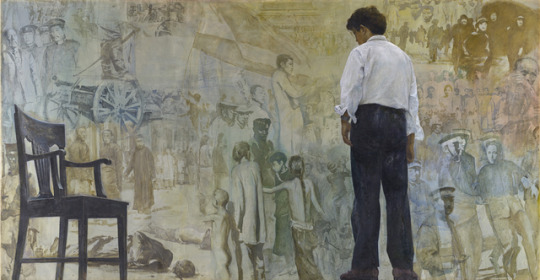
The Long Museum (Chinese: 龙美术馆) is a private art museum in Shanghai, China, founded by Liu Yiqian and his wife Wang Wei. The museum has two locations in Shanghai: the Long Museum Pudong and Long Museum West Bund.
The old Spruce in Bad Gastein Rudolf von Alt 1899
From the collection of Leopold Museum From 1887 onward, Rudolf von Alt would regularly travel in midsummer with his daughter, Louise, to Gastein from Salzburg. The melancholy expressed by the ...
Read More
Salon in the Apartment of Count Lanckoronski in Vienna Rudolf von Alt 1881
Salon in the Apartment of Count Lanckoronski in Vienna Rudolf von Alt 1881 From the collection of Cooper Hewitt, Smithsonian Design Museum This view depicts the Salon of the Polish ...
Read More
View from Sant’Onofrio on Rome Rudolf von Alt 1835
View from Sant'Onofrio on Rome Rudolf von Alt 1835 From the collection of Leopold Museum Details Title: View from Sant'Onofrio on Rome Date Created: 1835 Technique: Watercolour on paper Physical ...
Read More
Altaussee Lake and Face of Mount Trissel Rudolf von Alt 1859
Altaussee Lake and Face of Mount Trissel Rudolf von Alt 1859 From the collection of Leopold Museum Details Title: Altaussee Lake and Face of Mount Trissel Date Created: 1859 Technique: ...
Read More
Old fashioned priest’s daughter Ester Almqvist 1890 – 1899
Old fashioned priest's daughter Ester Almqvist 1890 - 1899 From the collection of Malmö Konstmuseum In Esther Almqvist, we meet a female artist who through her paintings gives us reflections ...
Read More
The Sawmill, December sun Ester Almqvist 1914
The Sawmill, December sun Ester Almqvist 1914 From the collection of Malmö Konstmuseum In Esther Almqvist, we meet a female artist who through her paintings gives us reflections and insights ...
Read More
Lingonberry Pickers on the Hallandsåsen Ester Almqvist 1928
Lingonberry Pickers on the Hallandsåsen Ester Almqvist 1928 From the collection of Malmö Konstmuseum In Esther Almqvist, we meet a female artist who through her paintings gives us reflections and ...
Read More
Chess Players Sir Lawrence Alma-Tadema 1865
Chess Players Sir Lawrence Alma-Tadema 1865 From the collection of Colección de Arte Amalia Lacroze de Fortabat The interior reveals an elaborately architecture decorated with paintings that touch on themes ...
Read More
Portrait of Ignacy Jan Paderewski Lawrence Alma-Tadema 1890
Portrait of Ignacy Jan Paderewski Lawrence Alma-Tadema 1890 From the collection of The National Museum in Warsaw This painting depicts Ignacy Paderewski, a world-renowned pianist and composer and the Prime ...
Read More
Scene from Shakespeare’s “The Taming of the Shrew” (Katharina and Petruchio) Washington Allston 1809
Scene from Shakespeare's "The Taming of the Shrew" (Katharina and Petruchio) Washington Allston 1809 From the collection of Philadelphia Museum of Art The figures in this meticulously executed scene respond ...
Read More
The Body of Christ with Two Angels Alessandro Alloriearly
The Body of Christ with Two Angels Alessandro Alloriearly 1590s From the collection of Museum of Fine Arts, Budapest The inventory of May 24, 1593 records among the effects in ...
Read More
The Abduction of Proserpine Alessandro Allori 1570
The Abduction of Proserpine Alessandro Allori 1570 From the collection of The J. Paul Getty Museum Pluto, god of the Underworld, seizes Proserpine, daughter of the corn-goddess Ceres, ready to ...
Read More
In a Cornfield (Ploughman with a white Horse) Ādams Alksnis
In a Cornfield (Ploughman with a white Horse) Ādams Alksnis From the collection of Latvian National Museum of Art Details Title: In a Cornfield (Ploughman with a white Horse) Date: ...
Read More
Scouts Ādams Alksnis
Scouts Ādams Alksnis From the collection of Latvian National Museum of Art Details Title: Scouts Date: 1897/1897 Physical Dimensions: w15.6 x h10.9 cm Painter: Ādams Alksnis Type: Drawings Rights: LNMA ...
Read More
Running Ādams Alksnis
Running Ādams Alksnis From the collection of Latvian National Museum of Art Details Title: Running Date: 1897/1897 Physical Dimensions: w41.2 x h27.2 cm Painter: Ādams Alksnis Type: Drawings & Watercolours ...
Read More
On the Way to Work Ādams Alksnis 1897
On the Way to Work Ādams Alksnis 1897 From the collection of Latvian National Museum of Art Details Title: On the Way to Work Date: 1897/1897 Physical Dimensions: w22 x ...
Read More
Kūru Ship (Sailing Boat) Ādams Alksnis 1897
Kūru Ship (Sailing Boat) Ādams Alksnis 1897 From the collection of Latvian National Museum of Art Details Title: Kūru Ship (Sailing Boat) Date: 1897/1897 Physical Dimensions: w39.7 x h30.5 cm ...
Read More
Sketch Ādams Alksnis 1897
Sketch Ādams Alksnis 1897 From the collection of Latvian National Museum of Art Details Title: Sketch Date: 1897/1897 Physical Dimensions: w34 x h25 cm Painter: Ādams Alksnis Type: Drawings Rights: ...
Read More
Christ on the Cross Alessandro Algardi 1647
Christ on the Cross Alessandro Algardi 1647 From the collection of National Gallery of Art, Washington DC Details Title: Christ on the Cross Creator: Alessandro Algardi External Link: For more ...
Read More
The Beheading of Saint Paul Vincenzo Foggini, Alessandro Algardi 1643-1647
The Beheading of Saint Paul Vincenzo Foggini, Alessandro Algardi (after)originally modelled 1643-1647; this example before 1753 From the collection of Los Angeles County Museum of Art Details Title: The Beheading ...
Read More
1
2
3
4
5
›
»
In 2016, a third location was opened in Chongqing and a Wuhan branch is scheduled for 2018.
var quads_screen_width = document.body.clientWidth; if ( quads_screen_width >= 1140 ) { /* desktop monitors */ document.write('<ins class="adsbygoogle" style="display:inline-block;width:300px;height:250px;" data-ad-client="pub-9117077712236756" data-ad-slot="1897774225" >'); (adsbygoogle = window.adsbygoogle || []).push({}); }if ( quads_screen_width >= 1024 && quads_screen_width < 1140 ) { /* tablet landscape */ document.write('<ins class="adsbygoogle" style="display:inline-block;width:300px;height:250px;" data-ad-client="pub-9117077712236756" data-ad-slot="1897774225" >'); (adsbygoogle = window.adsbygoogle || []).push({}); }if ( quads_screen_width >= 768 && quads_screen_width < 1024 ) { /* tablet portrait */ document.write('<ins class="adsbygoogle" style="display:inline-block;width:300px;height:250px;" data-ad-client="pub-9117077712236756" data-ad-slot="1897774225" >'); (adsbygoogle = window.adsbygoogle || []).push({}); }if ( quads_screen_width < 768 ) { /* phone */ document.write('<ins class="adsbygoogle" style="display:inline-block;width:300px;height:250px;" data-ad-client="pub-9117077712236756" data-ad-slot="1897774225" >'); (adsbygoogle = window.adsbygoogle || []).push({}); }
The Long Museum Pudong was officially opened to the public on December 18, 2012. The Long Museum West Bund opened on March 28, 2014 and was China’s largest private museum at the time of its opening.
About Long Museum
Founded by Chinese couple collectors, Mr. Liu Yiqian and his wife, Ms. Wang Wei, the Long Museum owns two large locations for exhibition and related functions: Long Museum Pudong and Long Museum West Bund. Located respectively in Pudong New Area and Binjiang, Xuhui District, they constitute a unique ecosystem of art in Shanghai: “One City, Two Museums.” As the largest private museums in China, the Long Museum boasts the richest collection nationwide. As world-renowned art collectors, Liu and Wang’s collection is systematically large, covering traditional, modern and contemporary Chinese art, “red classics” as well as contemporary art of Asia and Europe. Based on their private collections, the Long Museum is devoted not only to professional art exhibitions, research, and collections but also to the promotion of public cultural education. It aims to take up the responsibility of propelling continuous development and inheritance of art; focuses on the contrastive display and study of art, Western and Eastern, ancient and contemporary, while strengthening its local cultural roots;presents the diversity of visual art from a global perspective; systematically showcases the splendid achievements of Chinese art as well as the vitality of contemporary art all over the world; and eventually forges itself into a world-class private museum. Ms. Wang Wei, co-founder of the Museum, is the general director. Among the academic advisors of the Long Museum are Chen Lüsheng, Vice Director of the National Museum of China; Wang Huangsheng, the Director of the Art Museum of China Central Academy of Fine Arts and Zhao Li, a professor of China Central Academy of Fine Arts. These experts and scholars provide suggestions and support regarding the operation and development of the Museum.
Long Museum West Bund
It is located at the center of the West Bund Culture Corridor in Binjiang, Xuhui District, Shanghai– No. 3398, Longteng Avenue. Designed by Liu Yichun, a Chinese architect of Atelier Deshaus, the building covers an area of 33,000 square meters with up to 16,000 square meters for exhibition. The main part of the building is a unique umbrella-vaulted structure. There are four stories. The first and second floors above ground are devoted to contemporary art including paintings, sculptures, installations, and new media. The surface of the peculiar vault is built by faced concrete with a fine and smooth texture. Visually, it is in concert with the fashion space, “Hopper Corridor” (doulang), which was transformed from the former “Coal Hopper” (meiloudou) construction at Beipiao Port, thus creating a rational and tranquil sense of industry and primitivism as well as a sharp contrast between power and lightness. Meanwhile, it endows the Museum with an acute quality of contemporariness and creativity. The first basement is the permanent exhibition area for precious artifacts in ancient China and art works of the Republic of China. Resembling a “white box,” the rectangular exhibition hall highlights the historical continuance and intellectual profoundness of traditional Chinese art. The Long Museum West Bund does not adopt the closed spatial pattern typical of ordinary museums but functionally embraces openness and public involvement. For instance, on the above-ground floors, there is a river-view restaurant, a public courtyard, a concert hall, a café, and an art shop; in the first basement, there is an exhibition hall for children, a library, rooms for artifact restoration, and an art bookshop; in the second basement, there is a parking lot available for over 300 cars. Thanks to all these, art is no longer far away from the public but is seamlessly integrated into people’s daily life and leisure. This is exactly the original intention and sincere wish of the couple founders, Mr. Liu Yiqian and Ms. Wang Wei, when they set up the Museum.
Long Museum West Bund Shanghai, China was originally published on HiSoUR Art Collection
0 notes
Photo

#gallery-1 { margin: auto; } #gallery-1 .gallery-item { float: left; margin-top: 10px; text-align: center; width: 33%; } #gallery-1 img { border: 2px solid #cfcfcf; } #gallery-1 .gallery-caption { margin-left: 0; } /* see gallery_shortcode() in wp-includes/media.php */
Lawrence Alma-Tadema
Jan 8, 1836 – Jun 25, 1912
Sir Lawrence Alma-Tadema, OM, RA was a Frisian painter of special British denizenship.
Born in Dronrijp, the Netherlands, and trained at the Royal Academy of Antwerp, Belgium, he settled in England in 1870 and spent the rest of his life there. A classical-subject painter, he became famous for his depictions of the luxury and decadence of the Roman Empire, with languorous figures set in fabulous marbled interiors or against a backdrop of dazzling blue Mediterranean Sea and sky.
Though admired during his lifetime for his draftsmanship and depictions of Classical antiquity, his work fell into disrepute after his death, and only since the 1960s has it been re-evaluated for its importance within nineteenth-century English art.
Lawrence Alma-Tadema was originally published on HiSoUR Art Collection
0 notes
Photo

Mary Magdalene
Lourens Alma Tadema 1854
From the collection of
Rijksmuseum
Details
Title: Mary Magdalene
Creator: Lourens Alma Tadema
Date Created: 1854/1854
Physical Dimensions: h 31cm Ń w 35cm
External Link: See more details about this work on the Rijksmuseum Website http://hdl.handle.net/10934/RM0001.COLLECT.5775
Medium: paper
Rijksmuseum
Amsterdam, Netherlands
The Rijksmuseum is the museum of the Netherlands. Its world-famous masterworks from the Dutch Golden Age include the Milkmaid by Vermeer and Rembrandt’s Night Watch. The Rijksmuseum itself is also a masterpiece. The collection is presented in a stunning building with amazing interior design. In 80 galleries 8,000 objects tell the story of 800 years of Dutch art and history, from the Middle Ages to Mondrian. Every year, over 2.5 million visitors travel through the ages and experience a feeling of beauty and sense of time.
Lawrence Alma-Tadema
Jan 8, 1836 – Jun 25, 1912
Sir Lawrence Alma-Tadema, OM, RA was a Frisian painter of special British denizenship.
Born in Dronrijp, the Netherlands, and trained at the Royal Academy of Antwerp, Belgium, he settled in England in 1870 and spent the rest of his life there. A classical-subject painter, he became famous for his depictions of the luxury and decadence of the Roman Empire, with languorous figures set in fabulous marbled interiors or against a backdrop of dazzling blue Mediterranean Sea and sky.
Though admired during his lifetime for his draftsmanship and depictions of Classical antiquity, his work fell into disrepute after his death, and only since the 1960s has it been re-evaluated for its importance within nineteenth-century English art.
Mary Magdalene Lourens Alma Tadema 1854 was originally published on HiSoUR Art Collection
0 notes
Photo

Dromende vrouw
Lourens Alma Tadema 1875
From the collection of
Rijksmuseum
Details
Title: Dromende vrouw
Creator: Lourens Alma Tadema
Date Created: 1875/1875
Physical Dimensions: h 97mm – w 95mm
External Link: See more details about this work on the Rijksmuseum Website http://hdl.handle.net/10934/RM0001.COLLECT.71736
Medium: etching
Rijksmuseum
Amsterdam, Netherlands
The Rijksmuseum is the museum of the Netherlands. Its world-famous masterworks from the Dutch Golden Age include the Milkmaid by Vermeer and Rembrandt’s Night Watch. The Rijksmuseum itself is also a masterpiece. The collection is presented in a stunning building with amazing interior design. In 80 galleries 8,000 objects tell the story of 800 years of Dutch art and history, from the Middle Ages to Mondrian. Every year, over 2.5 million visitors travel through the ages and experience a feeling of beauty and sense of time.
Lawrence Alma-Tadema
Jan 8, 1836 – Jun 25, 1912
Sir Lawrence Alma-Tadema, OM, RA was a Frisian painter of special British denizenship.
Born in Dronrijp, the Netherlands, and trained at the Royal Academy of Antwerp, Belgium, he settled in England in 1870 and spent the rest of his life there. A classical-subject painter, he became famous for his depictions of the luxury and decadence of the Roman Empire, with languorous figures set in fabulous marbled interiors or against a backdrop of dazzling blue Mediterranean Sea and sky.
Though admired during his lifetime for his draftsmanship and depictions of Classical antiquity, his work fell into disrepute after his death, and only since the 1960s has it been re-evaluated for its importance within nineteenth-century English art.
Dromende vrouw Lourens Alma Tadema 1875 was originally published on HiSoUR Art Collection
1 note
·
View note
Photo

Sfinx
Lourens Alma Tadema 1875
From the collection of
Rijksmuseum
Details
Title: Sfinx
Creator: Lourens Alma Tadema
Date Created: 1875/1875
Physical Dimensions: h 97mm – w 95mm
External Link: See more details about this work on the Rijksmuseum Website http://hdl.handle.net/10934/RM0001.COLLECT.71739
Medium: etching
Rijksmuseum
Amsterdam, Netherlands
The Rijksmuseum is the museum of the Netherlands. Its world-famous masterworks from the Dutch Golden Age include the Milkmaid by Vermeer and Rembrandt’s Night Watch. The Rijksmuseum itself is also a masterpiece. The collection is presented in a stunning building with amazing interior design. In 80 galleries 8,000 objects tell the story of 800 years of Dutch art and history, from the Middle Ages to Mondrian. Every year, over 2.5 million visitors travel through the ages and experience a feeling of beauty and sense of time.
Lawrence Alma-Tadema
Jan 8, 1836 – Jun 25, 1912
Sir Lawrence Alma-Tadema, OM, RA was a Frisian painter of special British denizenship.
Born in Dronrijp, the Netherlands, and trained at the Royal Academy of Antwerp, Belgium, he settled in England in 1870 and spent the rest of his life there. A classical-subject painter, he became famous for his depictions of the luxury and decadence of the Roman Empire, with languorous figures set in fabulous marbled interiors or against a backdrop of dazzling blue Mediterranean Sea and sky.
Though admired during his lifetime for his draftsmanship and depictions of Classical antiquity, his work fell into disrepute after his death, and only since the 1960s has it been re-evaluated for its importance within nineteenth-century English art.
Sfinx Lourens Alma Tadema 1875 was originally published on HiSoUR Art Collection
0 notes
Photo
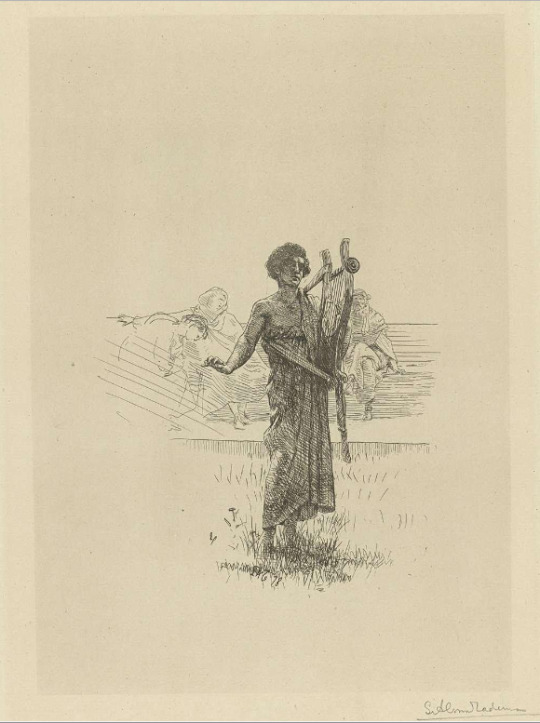
Schets voor de improvisator
Lourens Alma Tadema 1878
From the collection of
Rijksmuseum
Details
Title: Schets voor de improvisator
Creator: Lourens Alma Tadema
Date Created: 1878/1878
Physical Dimensions: h 280mm – w 197mm
External Link: See more details about this work on the Rijksmuseum Website http://hdl.handle.net/10934/RM0001.COLLECT.71734
Medium: etching
Rijksmuseum
Amsterdam, Netherlands
The Rijksmuseum is the museum of the Netherlands. Its world-famous masterworks from the Dutch Golden Age include the Milkmaid by Vermeer and Rembrandt’s Night Watch. The Rijksmuseum itself is also a masterpiece. The collection is presented in a stunning building with amazing interior design. In 80 galleries 8,000 objects tell the story of 800 years of Dutch art and history, from the Middle Ages to Mondrian. Every year, over 2.5 million visitors travel through the ages and experience a feeling of beauty and sense of time.
Lawrence Alma-Tadema
Jan 8, 1836 – Jun 25, 1912
Sir Lawrence Alma-Tadema, OM, RA was a Frisian painter of special British denizenship.
Born in Dronrijp, the Netherlands, and trained at the Royal Academy of Antwerp, Belgium, he settled in England in 1870 and spent the rest of his life there. A classical-subject painter, he became famous for his depictions of the luxury and decadence of the Roman Empire, with languorous figures set in fabulous marbled interiors or against a backdrop of dazzling blue Mediterranean Sea and sky.
Though admired during his lifetime for his draftsmanship and depictions of Classical antiquity, his work fell into disrepute after his death, and only since the 1960s has it been re-evaluated for its importance within nineteenth-century English art.
Schets voor de improvisator Lourens Alma Tadema 1878 was originally published on HiSoUR Art Collection
0 notes
Photo
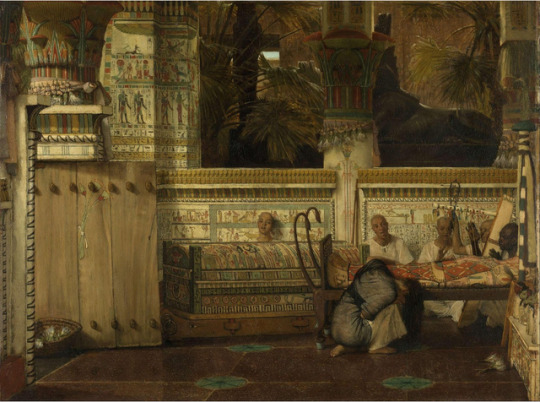
The Egyptian Widow
Lourens Alma Tadema 1872
From the collection of
Rijksmuseum
Details
Title: The Egyptian Widow
Creator: Lourens Alma Tadema
Date Created: 1872/1872
Physical Dimensions: h 74.9cm – w 99.1cm
External Link: See more details about this work on the Rijksmuseum Website http://hdl.handle.net/10934/RM0001.COLLECT.5776
Medium: oil on panel
Rijksmuseum
Amsterdam, Netherlands
The Rijksmuseum is the museum of the Netherlands. Its world-famous masterworks from the Dutch Golden Age include the Milkmaid by Vermeer and Rembrandt’s Night Watch. The Rijksmuseum itself is also a masterpiece. The collection is presented in a stunning building with amazing interior design. In 80 galleries 8,000 objects tell the story of 800 years of Dutch art and history, from the Middle Ages to Mondrian. Every year, over 2.5 million visitors travel through the ages and experience a feeling of beauty and sense of time.
Lawrence Alma-Tadema
Jan 8, 1836 – Jun 25, 1912
Sir Lawrence Alma-Tadema, OM, RA was a Frisian painter of special British denizenship.
Born in Dronrijp, the Netherlands, and trained at the Royal Academy of Antwerp, Belgium, he settled in England in 1870 and spent the rest of his life there. A classical-subject painter, he became famous for his depictions of the luxury and decadence of the Roman Empire, with languorous figures set in fabulous marbled interiors or against a backdrop of dazzling blue Mediterranean Sea and sky.
Though admired during his lifetime for his draftsmanship and depictions of Classical antiquity, his work fell into disrepute after his death, and only since the 1960s has it been re-evaluated for its importance within nineteenth-century English art.
The Egyptian Widow Lourens Alma Tadema 1872 was originally published on HiSoUR Art Collection
0 notes
Photo
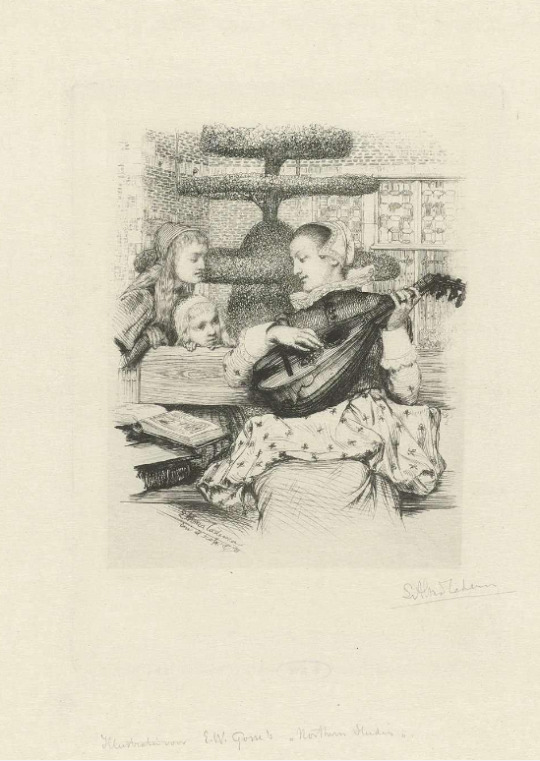
Portret van Maria Tesselschade Roemers Visscher
Lourens Alma Tadema 1876/1877
From the collection of
Rijksmuseum
Details
Title: Portret van Maria Tesselschade Roemers Visscher
Creator: Lourens Alma Tadema
Date Created: 1876/1877
Physical Dimensions: h 201mm – w 150mm
External Link: See more details about this work on the Rijksmuseum Website http://hdl.handle.net/10934/RM0001.COLLECT.71732
Medium: etching
Rijksmuseum
Amsterdam, Netherlands
The Rijksmuseum is the museum of the Netherlands. Its world-famous masterworks from the Dutch Golden Age include the Milkmaid by Vermeer and Rembrandt’s Night Watch. The Rijksmuseum itself is also a masterpiece. The collection is presented in a stunning building with amazing interior design. In 80 galleries 8,000 objects tell the story of 800 years of Dutch art and history, from the Middle Ages to Mondrian. Every year, over 2.5 million visitors travel through the ages and experience a feeling of beauty and sense of time.
Lawrence Alma-Tadema
Jan 8, 1836 – Jun 25, 1912
Sir Lawrence Alma-Tadema, OM, RA was a Frisian painter of special British denizenship.
Born in Dronrijp, the Netherlands, and trained at the Royal Academy of Antwerp, Belgium, he settled in England in 1870 and spent the rest of his life there. A classical-subject painter, he became famous for his depictions of the luxury and decadence of the Roman Empire, with languorous figures set in fabulous marbled interiors or against a backdrop of dazzling blue Mediterranean Sea and sky.
Though admired during his lifetime for his draftsmanship and depictions of Classical antiquity, his work fell into disrepute after his death, and only since the 1960s has it been re-evaluated for its importance within nineteenth-century English art.
Portret van Maria Tesselschade Roemers Visscher Lourens Alma Tadema 1876/1877 was originally published on HiSoUR Art Collection
0 notes
Photo
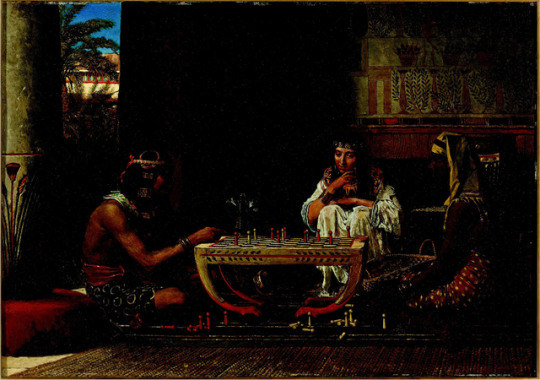
Chess Players
Sir Lawrence Alma-Tadema 1865
From the collection of
Colección de Arte Amalia Lacroze de Fortabat
The interior reveals an elaborately architecture decorated with paintings that touch on themes that archaeology put within our reach and that Alma-Tadema knew how to glean from the collections of the museums he visited. Architectural details and decorative motifs are meticulously reproduced, as can be seen in the column with its lotus flower decoration, one of the most commonly used motifs in ancient Egypt. In addition, his handling of the furnishings and other objects that appear in the room is notable, particularly the table where the game takes place, converted here into an important focal point of the action portrayed. The clothing and personal ornaments of the people who appear in this interior receive similar treatment. The artist also includes a view of the exterior, showing a garden with typical plants such as palm trees, enclosed within a wall, reminiscent of the wall paintings that decorate tombs that have survived intact until today. An essential atmospheric touch completes the scene, an intense blue sky that gives closure to the exterior.
An interesting contrast of light is created between interior and exterior, and the artist makes use of this to emphasize certain of the figures who participate in the scene, in particular the female figure who watches the game intently, certainly pondering over which moves the players should make.
It was painted in 1865, shortly after his first visit to London on the occasion of the International Exposition of 1863, where Alma-Tadema was fascinated by the objects from classic and Egyptian cultures that he saw at the British Museum. In addition to the technical virtuosity of this piece, which was recognized by no less than John Ruskin, one of the most eminent critics of the day, this piece is a good example of this phase of his career.
Details
Title: Chess Players
Creator: Sir Lawrence Alma-Tadema
Date Created: 1865
Physical Dimensions: 40.5 x 55.5 cm
Medium: Oil on wood panel
Colección de Arte Amalia Lacroze de Fortabat
Buenos Aires, Argentina
The Collection gathers an important selection of works of art belonging to Argentinian and international artists. In the lower floors of the building, the national tour is dedicated to the problematics of Argentinian art in the 19th and 20th century, with emblematic artists such as Prilidiano Pueyrredón, Emilio Pettoruti, Xul Solar and Antonio Berni, among others. There is also an area exclusively dedicated for international art with works by great masters like Pieter Brueghel II and Joseph M. William Turner. Temporary exhibitions are held on upper levels; besides, a section dedicated to ancient civilizations is presented on the second floor of the Collection.
Lawrence Alma-Tadema
Jan 8, 1836 – Jun 25, 1912
Sir Lawrence Alma-Tadema, OM, RA was a Frisian painter of special British denizenship.
Born in Dronrijp, the Netherlands, and trained at the Royal Academy of Antwerp, Belgium, he settled in England in 1870 and spent the rest of his life there. A classical-subject painter, he became famous for his depictions of the luxury and decadence of the Roman Empire, with languorous figures set in fabulous marbled interiors or against a backdrop of dazzling blue Mediterranean Sea and sky.
Though admired during his lifetime for his draftsmanship and depictions of Classical antiquity, his work fell into disrepute after his death, and only since the 1960s has it been re-evaluated for its importance within nineteenth-century English art.
Chess Players Sir Lawrence Alma-Tadema 1865 was originally published on HiSoUR Art Collection
0 notes
Photo
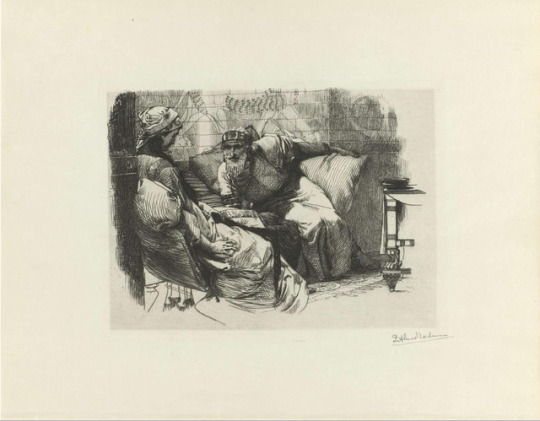
Twee Perzen
Lourens Alma Tadema 1882
From the collection of
Rijksmuseum
Details
Title: Twee Perzen
Creator: Lourens Alma Tadema
Date Created: 1882/1882
Physical Dimensions: h 147mm – w 201mm
External Link: See more details about this work on the Rijksmuseum Website http://hdl.handle.net/10934/RM0001.COLLECT.365920
Medium: etching
Rijksmuseum
Amsterdam, Netherlands
The Rijksmuseum is the museum of the Netherlands. Its world-famous masterworks from the Dutch Golden Age include the Milkmaid by Vermeer and Rembrandt’s Night Watch. The Rijksmuseum itself is also a masterpiece. The collection is presented in a stunning building with amazing interior design. In 80 galleries 8,000 objects tell the story of 800 years of Dutch art and history, from the Middle Ages to Mondrian. Every year, over 2.5 million visitors travel through the ages and experience a feeling of beauty and sense of time.
Lawrence Alma-Tadema
Jan 8, 1836 – Jun 25, 1912
Sir Lawrence Alma-Tadema, OM, RA was a Frisian painter of special British denizenship.
Born in Dronrijp, the Netherlands, and trained at the Royal Academy of Antwerp, Belgium, he settled in England in 1870 and spent the rest of his life there. A classical-subject painter, he became famous for his depictions of the luxury and decadence of the Roman Empire, with languorous figures set in fabulous marbled interiors or against a backdrop of dazzling blue Mediterranean Sea and sky.
Though admired during his lifetime for his draftsmanship and depictions of Classical antiquity, his work fell into disrepute after his death, and only since the 1960s has it been re-evaluated for its importance within nineteenth-century English art.
Twee Perzen Lourens Alma Tadema 1882 was originally published on HiSoUR Art Collection
0 notes
Photo
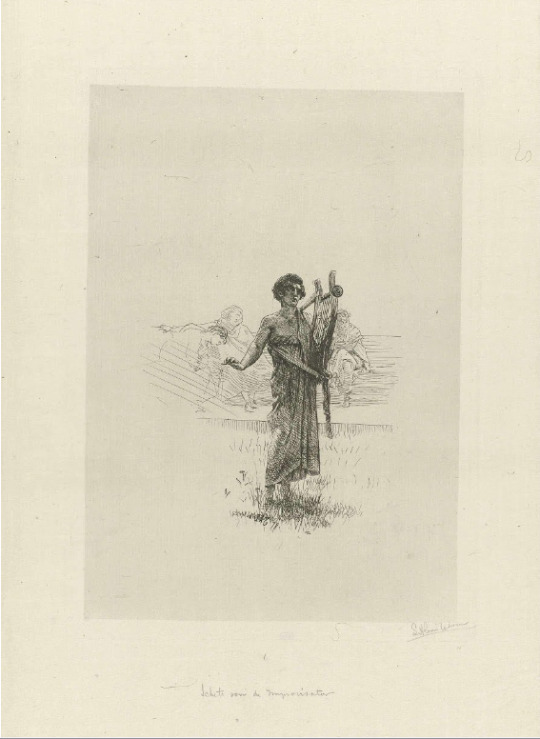
Schets voor de improvisator
Lourens Alma Tadema 1878
From the collection of
Rijksmuseum
Details
Title: Schets voor de improvisator
Creator: Lourens Alma Tadema
Date Created: 1878/1878
Physical Dimensions: h 282mm – w 204mm
External Link: See more details about this work on the Rijksmuseum Website http://hdl.handle.net/10934/RM0001.COLLECT.71733
Medium: etching
Rijksmuseum
Amsterdam, Netherlands
The Rijksmuseum is the museum of the Netherlands. Its world-famous masterworks from the Dutch Golden Age include the Milkmaid by Vermeer and Rembrandt’s Night Watch. The Rijksmuseum itself is also a masterpiece. The collection is presented in a stunning building with amazing interior design. In 80 galleries 8,000 objects tell the story of 800 years of Dutch art and history, from the Middle Ages to Mondrian. Every year, over 2.5 million visitors travel through the ages and experience a feeling of beauty and sense of time.
Lawrence Alma-Tadema
Jan 8, 1836 – Jun 25, 1912
Sir Lawrence Alma-Tadema, OM, RA was a Frisian painter of special British denizenship.
Born in Dronrijp, the Netherlands, and trained at the Royal Academy of Antwerp, Belgium, he settled in England in 1870 and spent the rest of his life there. A classical-subject painter, he became famous for his depictions of the luxury and decadence of the Roman Empire, with languorous figures set in fabulous marbled interiors or against a backdrop of dazzling blue Mediterranean Sea and sky.
Though admired during his lifetime for his draftsmanship and depictions of Classical antiquity, his work fell into disrepute after his death, and only since the 1960s has it been re-evaluated for its importance within nineteenth-century English art.
Schets voor de improvisator Lourens Alma Tadema 1878 was originally published on HiSoUR Art Collection
0 notes